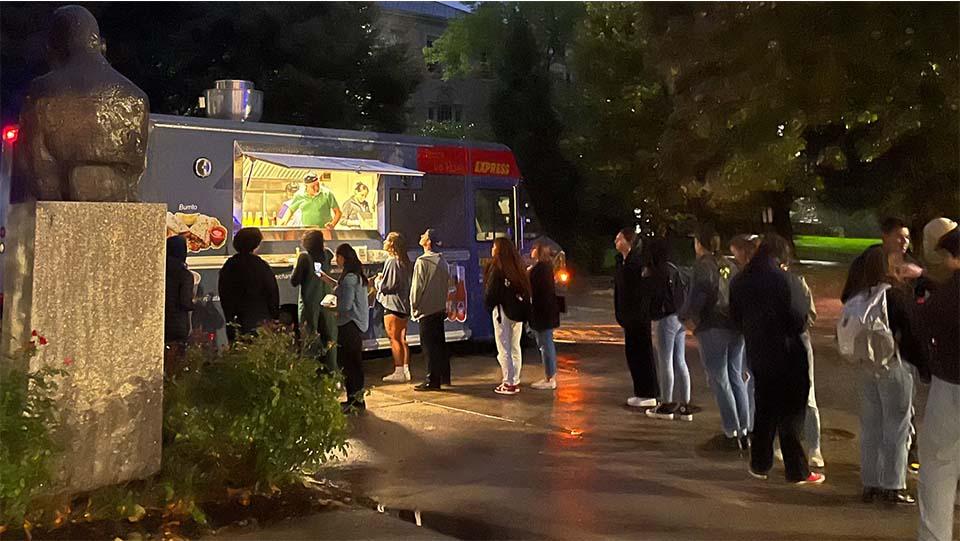Sponsored by the College of Arts and Sciences, a panel titled “¡Presente! Visibilizing Latinx Culture and Identities Today” showcased Latino representation in media and art on Sept. 27 at 5:30 p.m..
The lecture showcased local and international Latino culture in the world of art. Erin McCutcheon, an assistant professor of arts of the Americas chose the panelists, according to co-speaker and Assistant Teaching Professor of Spanish William Stark. The panel consists of Latino artists and researchers.
McCutcheon began discussing Latin American art history. She displayed the results of a Google search with the words, “American art history,” that represented predominantly white artists.
Highlighting Latino artists, McCutcheon discussed Jose Clemente Orozco. Oroszo was a Mexican muralist during the 1930’s and hired by the government to expand public arts programs in the United States, according to McCutcheon.
Panelist Susana de los Heros, University of Rhode Island Professor of Spanish, overviewed the history of Latino representation in film. De los Heros applied her skills as a linguist to research this topic.
“I decided to try and prove whether or not ethnicity and accent was a source of humor, but a humor that subordinates,” de los Heros said.
Between 1910 and 1960, the film industry presented stereotypical depictions of Latinx people, according to de los Heros, including wearing sombreros and using accents for comedic relief.
De los Heros spoke about the American comedy-drama, “Jane the Virgin”, as an example of better, more appropriate representation of Latino culture. According to her, representation has improved in modern film.
Director of Rhode Island Latino Arts (RILA) Marta Martínez showcased the local presence of Latino art.
Martínez said she struggled connecting to her Mexican roots in Rhode Island. RILA takes initiatives to enrich the community with Latino culture.
RILA’s initiatives include organizing murals, meetups for Latino artists and implementing cultural practices in children’s education. RILA implements Puerto Rican dance culture in the second grade curriculum at the Leviton Dual Language School in Providence.
Martínez emphasized the acceptance her organization tries to convey.
“Our staff reflects the community which we serve, we respect what everyone brings to the table,” Martínez said. “We accept and encourage social and cultural change.”
This includes accepting the inability to speak Spanish, for example.
As well as presenting art and culture, the state of Rhode Island has initiatives to actively help improve the quality of life.
Associate Teaching Professor of Graphic Design Clarisa Carubin has been working on a National Institute of Health grant. The grant, “Diet Quality Improvement Campaign for Hispanic and Minorities Preschoolers Parents,” uses graphics by Carubin to promote healthy diets in low-income, Hispanic households, according to her.
Overall, research will be done via the grant for finding solutions to poor quality diets.
Presented by McCutcheon, artist AGONZA painted a mural in Olneyville, a southside neighborhood in Providence, Rhode Island. The mural incorporated children’s handprints.
“It’s a way to not only have an image on the wall, but to actually have the community feel a part of the spaces they occupy,” McCutcheon said.
AGONZA was also a panelist for the discussion.
AGONZA noticed the lack of Latino representation in the American curriculum while attending school in the Dominican Republic for seven years. She said she showcases underrepresented communities through her art.
“I try to tell stories through my art,” AGONZA said. “It’s who I am and what my community, what the people around me, go through.”
Panelist Marleny Luna shared her journey as an artist and poem she wrote.
“What I write about is being between two worlds,” Luna said.
As a Latino woman who lives in the United States, living between two cultures and two languages can be challenging, according to Luna. There are different expectations for Latino and American cultures.
The poem conveyed the anxiety of interviewing for citizenship by the U.S. embassy. This is a common experience among Latino people who weren’t always U.S. citizens.
According to Luna’s poem, the embassy’s treatment of Latino people is belittling and anxiety-ridden. Remembering your own information can feel like an impossible test, according to Luna.
“All of the sudden, your hopes and dreams start getting hyper and pregnant,” Luna said. “Your possibility thermometer explodes, you engage in this negotiation between your thoughts and feelings, to avoid forgetting and mixing up information that you’re supposed to remember.”
Along with the embassy’s treatment during the citizenship process, Luna explores themes of domestic violence in her poems.
Pablo Youngs, another panelist and artist out of Providence, Rhode Island, has paintings and printmakings inspired by Mexican culture. Youngs said most of his art is inspired by themes surrounding life and death.
A gallery in Green Hall showcases Youngs’ art through October. According to Youngs, the majority of his art is inspired by The Day of the Dead, an annual celebration originating from Mexico.
Youngs said his art showcases skeletons, one of his favorite symbols of the holiday.
“They’re often emotionless, genderless, ageless, figureless,” Youngs said. “I think the idea of the skeleton being present in art has always been a beautiful image.”
Youngs praised Providence as the best place to be as an artist. According to him, the southside of Providence has a rich art scene.
“Latin America’s made up of 21 different countries and we’re all very distinct,” Martínez said. “Even though we’re put under one umbrella.”
Organizations like RILA and artists like AGONZA intentionally share Latino culture to expand representation in Rhode Island. As Luna said, as well as Martínez, the ability to share and converse about your culture with your community is important.





